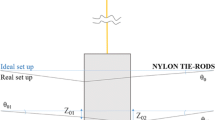Abstract
In this paper we describe a new method for measuring damping in flexural vibration of filamentous matter, such as polymeric or metallic fibers. This method enables us to measure the damping characteristics of very thin fibers (down to lateral dimensions of a few micrometers). The fiber sample is clamped at one extremity and excited in the flexural vibration mode of a cantilever beam configuration, using a piezoelectric actuator. While the fiber sample vibrates around a flexural eigenfrequency, structural damping is determined from the measurement of the curve of phase difference between excitation and motion. This technique does not require the amplitude of the fiber motion to be determined. The phase curve is inferred from the periodic disturbance occurring when the fiber acts as a shutter for a light beam. This method can be applied to fibers of arbitrary shape and material. Examples are shown of measurements with polymer and metallic fibers. Flexural damping is evaluated at atmospheric pressure and in vacuum. The technique is validated by a comparison with polypropylene damping measurements from standard dynamic mechanical thermal analysis techniques.
Similar content being viewed by others
Abbreviations
- E 1 :
-
storage modulus
- E 2 :
-
loss modulus
- f :
-
vibration frequency
- T(f) :
-
system transfer function
- ϕ(f):
-
phase of the transfer function
- f res :
-
system resonance frequency
- α:
-
slope of ϕ(f) evaluated at resonance
- w :
-
flexural displacement of the fiber
- w 0 :
-
exciting displacement applied to the fiber
- D :
-
energy loss in one vibration period
- U m :
-
maximum potential energy of the vibrating structure
- Q :
-
quality factor of the vibration
- Q mat :
-
quality factor due to material viscoelasticity
- Q air :
-
quality factor due to air damping
- Q clamp :
-
quality factor due to damping at the clamp
- η:
-
loss factor of the vibration
- η mat :
-
loss factor due to material viscoelasticity
- η air :
-
loss factor due to air damping
- η clamp :
-
loss factor due to damping at the clamp
- η vacuum :
-
loss factor evaluated in a vacuum chamber
- σ:
-
loss angle due to material viscoelasticity
References
Sepe, M.P., Dynamic Mechanical Analysis for Plastics Engineering, Plastic Design Library, Norwich, NY (1998).
Neimark, M.A., Andermann, M.L., Hopfield, J.J., andMoore, C.J., “Vibrissae Resonance as a Transduction Mechanism for Tactile Encoding,” Journal of Neuroscience,23 6499–6509 (2003).
Carvell, G.E., andSimons, D.J., “Task- and Subject-related Differences in Sensorimotor Behavior During Active Touch,” Somatosensory and Motor Research,12 1–9 (1995).
Huck, P.J., andBaddiel, C.B., “The Mechanical Properties of Virgin and Treated Human Hair Fibers: A Study by Means of the Oscillating Beam Method,” Journal of the Society of Cosmetic Chemists,22 401–410, (1971).
Baltenneck, F., Franbourg, A., Leroy, F., Mandon, M., andVayssie, C., “A New Approach to the Bending Properties of Hair Fibers,” Journal of Cosmetic Science,52 (6),355–368 (2001).
Zener, C.M., Elasticity and Anelasticity of Metals, University Press, Chicago (1948).
Bert, C.W., “Material Damping: An Introductory Review of Mathematical Models, Measures and Experimental Techniques,” Journal of Sound and Vibration,29 (2),129–153 (1973).
Bishop, R.E.D. andJohnson, D.C., The Mechanics of Vibration, Cambridge University Press, Cambridge (1979).
Kinra, V.K. andWren, G.G., “Axial Damping in Metal-matrix Composites 1. A New Technique for Measuring Phase difference to 10−4 Radians,” EEXPERIMENTAL MECHANICS32 (2),163–171 (1992).
Åberg, J. andWidell, B., “Uniaxial Material Damping Measurements Using a Fiber Optic Lattice: A Discussion of its Performance Envelope,” EXPERIMENTAL MECHANICS,44 (1),33–36 (2004).
Jones, D.I.G., Handbook of Viscoelastic Vibration Damping, Wiley, New York (2001).
Hartmann, M.J., Johnson, N.J., Towal, R.B., andAssad, C., “Mechanical Characteristics of Rat Vibrassae: Resonant Frequencies and Damping in Isolated Whiskers and in the Awake Behaving Animal,” Journal of Neuroscience,23 (16),6510–6519 (2003).
DiCarlo, J.A. andWilliams, W., “Dynamic Modulus and Damping of Boron, Silicon Carbide, and Alumina Fibers,” Ceramic Engineering and Science Proceedings,1 672–692 (1980).
Kennedy, C.C. andPancu, C.D.P., “Use of Vectors in Vibration Measurement and Analysis,” Journal of the Aeronautical Sciences,14 (11),603–625 (1947).
Gibson, R.F., Thirumalai, R., and Pant, R., Apparatus and Process for Measuring Mechanical Properties of Fibers, US Patent 5269181.
Gibson, R.F. andPlunkett, R., “Forced-vibration Technique for Measurement of Material Damping,” EXPERIMENTAL MECHANICS,17, (8), 297–302 (1977).
Pendered, J.W. andBishop, R.E.D., “A Critical Introduction to Some Industrial Resonance Testing Techniques,” Journal of Mechanical Engineering Science,5, (4),345–367 (1963).
Dual, J., Experimental Methods in Wave Propagation in Solids and Dynamic Viscometry, Ph.D. Thesis, ETH Zurich (1989).
Mazza, E., Valtorta, D., and Vollmann, J., Device and Method for Testing Flexural Damping in Fibers and Whiskers, European Patent Application 03405890.9.
Lazan, B.B., Damping of Materials and Members in Structural Mechanics, Pergamon Press, Oxford (1968).
Harris, C.M., andPiersol, A.G., Harris' Shock and Vibration Handbook, McGraw-Hill, New York (2002).
Crandall, D.H. “On Scaling Laws for Material Damping,” NASA TN D-1467 (1962).
Granick, N. and Stern, J.E., “Material Damping of Aluminum by a Resonant Dwell Technique,” NASA TN D-2893 (1965).
Antognozzi, M., Haschke, H., andMilesa, M.J., “New Method to Measure the Oscillation of a Cylindrical Cantilever: The Laser Reflection Detection System,” Review of Scientific Instruments,71,1689–1694 (2000).
Blom, F.R., Bouwstra, S., Elwenspoek, M., andFluitman, J.H.J., “Dependency of the Quality Factor of Micromachined Silicon Beam Resonators on Pressure and Geometry,” Journal of Vacuum Science Technology B10 19–26 (1992).
Humphrey, J.A.C., Devarakonda, R., Iglesias, I., andBarth, F.G., “Dynamics of Arthropod Filiform Hairs. Mathematical Modeling of the Hair and Air Motions,” Philosophical Transactions of the Royal Society B240 423–444 (1993).
Author information
Authors and Affiliations
Rights and permissions
About this article
Cite this article
Valtorta, D., Lefèvre, J. & Mazza, E. A new method for measuring damping in flexural vibration of thin fibers. Experimental Mechanics 45, 433–439 (2005). https://doi.org/10.1007/BF02427991
Received:
Revised:
Issue Date:
DOI: https://doi.org/10.1007/BF02427991



